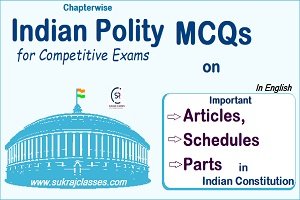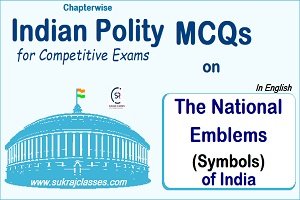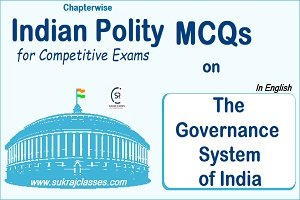
Indian Polity MCQs on ”The Preamble of Indian Constitution”
Que- 16. Which part of the Indian Constitution has been described as the ‘Soul’ of the Constitution?
(A) Fundamental Rights
(B) Directive Principles of State Policy
(C) The Preamble
(D) Right to Constitutional Remedies
Que- 17. Which of the following is true in relation to the Preamble of Constitution of India?
(A) The words ‘Socialist’ and ‘Secular’ were not the part of the Preamble on the enforcement of Constitution in 1950
(B) The above mentioned words were inserted by amendment in 1977
(C) The above mentioned words were inserted by amendment in 1985
(D) These two words are not part of the Preamble
Que- 18. Who has termed Constitution a sacred document?
(A) B.R. Ambedkar
(B) Mahatma Gandhi
(C) Deendayal Upadhyay
(D) Mohammad Ali Jinnah
Que- 19. Who among the following called the Preamble of Indian Constitution ‘the horoscope of one sovereign, democratic republic’?
(A) Jawaharlal Nehru
(B) Vallabhbhai Patel
(C) B.R. Ambedkar
(D) K.M. Munshi
Que- 20. In which of the following cases the Supreme Court regarded Preamble as a part of the basic structure of India Constitution?
(A) Beru Bari Case
(B) A.K. Gopalan Case
(C) Privy Purse Case
(D) Keshwanand Bharti Case
Que- 21. In which of the following cases Supreme Court held that ‘The Preamble forms part of the Constitution’?
(A) Union of India Vs. Dr. Kohli
(B) Banarsidas Vs. State of U.P.
(C) Bommai Vs. Union of India
(D) Malak Singh Vs. State of Punjab
Que- 22. The ideals and objectives outlined in the Preamble of the Indian Constitution have been further elaborated in……..?
(A) The Chapter on Fundamental Rights
(B) The Chapter on Directive Principles of State Policy
(C) The Chapter on Directive Principles of State Policy, Fundamental Rights and Fundamental Duties
(D) Nowhere else in the text of the Constitution
Que- 23. ‘Economic Justice’ as one of the objectives of the Indian Constitution has been provided in…….?
(A) The Preamble and the Fundamental Rights
(B) The Preamble and the Directive Principles of State Policy
(C) The Fundamental Rights and the Directive Principles of State Policy
(D) None of the above
Que- 24. The objective of Indian Constitution is reflected in which of the following?
(A) Fundamental Rights
(B) Preamble of the Constitution
(C) Directive Principles of State Policy
(D) Parliament
Que- 25. The mind of the makers of the Constitution of India is reflected in which of the following?
(A) The Preamble
(B) The Fundamental Rights
(C) The Directive Principles of State Policy
(D) The Fundamental Duties
Que- 26. One of the implications of equality in society is the absence of…….?
(A) Privileges
(B) Restraints
(C) Competition
(D) Ideology
Que- 27. How many types of justice has been enshrined in the Preamble of the Constitution of India?
(A) Two
(B) Three
(C) One
(D) Four
Que- 28. Which of the following is correct?
(A) Social equality is not guaranteed in our Constitution
(B) Social equality already existed in our country
(C) Social equality is guaranteed in our Constitution
(D) None of the above.
Que- 29. Consider the following statements in regards to ‘The Preamble of Constitution’ and give correct answer by using the given options below.
1. The objectives Resolution by Jawaharlal Nehru finally became Preamble.
2. It is non-Justiciable.
3. It can’t be amended.
4. Preamble cannot override the specific provision of the Constitution.
Options:
(A) Only 1 and 2
(B) Only 1, 2 and 4
(C) Only 1, 2 and 3
(D) Only 2, 3 and 4
Que- 30. Which of the following words have been added to the Preamble by the 42nd Amendment?
1. Socialist
2. Gram Swarajya
3. Secular
4. Sovereign
Select the correct answer by using the code given below.
(A) 1, 2 and 3
(B) 1 and 3
(C) 1, 2 and 4
(D) 2, 3 and 4





